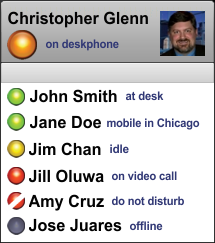Related Research Articles
In computer network engineering, an Internet Standard is a normative specification of a technology or methodology applicable to the Internet. Internet Standards are created and published by the Internet Engineering Task Force (IETF). They allow interoperation of hardware and software from different sources which allows internets to function. As the Internet became global, Internet Standards became the lingua franca of worldwide communications.

The Internet Engineering Task Force (IETF) is a standards organization for the Internet and is responsible for the technical standards that make up the Internet protocol suite (TCP/IP). It has no formal membership roster or requirements and all its participants are volunteers. Their work is usually funded by employers or other sponsors.
A Request for Comments (RFC) is a publication in a series from the principal technical development and standards-setting bodies for the Internet, most prominently the Internet Engineering Task Force (IETF). An RFC is authored by individuals or groups of engineers and computer scientists in the form of a memorandum describing methods, behaviors, research, or innovations applicable to the working of the Internet and Internet-connected systems. It is submitted either for peer review or to convey new concepts, information, or, occasionally, engineering humor.
The Session Initiation Protocol (SIP) is a signaling protocol used for initiating, maintaining, and terminating communication sessions that include voice, video and messaging applications. SIP is used in Internet telephony, in private IP telephone systems, as well as mobile phone calling over LTE (VoLTE).

Instant messaging (IM) technology is a type of synchronous computer-mediated communication involving the immediate (real-time) transmission of messages between two or more parties over the Internet or another computer network. Originally involving simple text message exchanges, modern IM applications and services tend to also feature the exchange of multimedia, emojis, file transfer, VoIP, and video chat capabilities.
An application layer is an abstraction layer that specifies the shared communication protocols and interface methods used by hosts in a communications network. An application layer abstraction is specified in both the Internet Protocol Suite (TCP/IP) and the OSI model. Although both models use the same term for their respective highest-level layer, the detailed definitions and purposes are different.

Extensible Messaging and Presence Protocol is an open communication protocol designed for instant messaging (IM), presence information, and contact list maintenance. Based on XML, it enables the near-real-time exchange of structured data between two or more network entities. Designed to be extensible, the protocol offers a multitude of applications beyond traditional IM in the broader realm of message-oriented middleware, including signalling for VoIP, video, file transfer, gaming and other uses.
SIMPLE, the Session Initiation Protocol for Instant Messaging and Presence Leveraging Extensions, is an instant messaging (IM) and presence protocol suite based on Session Initiation Protocol (SIP) managed by the Internet Engineering Task Force.
Message-oriented middleware (MOM) is software or hardware infrastructure supporting sending and receiving messages between distributed systems. Message-oriented middleware is in contrast to streaming-oriented middleware where data is communicated as a sequence of bytes with no explicit message boundaries. Note that streaming protocols are almost always built above protocols using discrete messages such as frames (Ethernet), datagrams (UDP), packets (IP), cells (ATM), et al.
A Service record is a specification of data in the Domain Name System defining the location, i.e., the hostname and port number, of servers for specified services. It is defined in RFC 2782, and its type code is 33. Some Internet protocols such as the Session Initiation Protocol (SIP) and the Extensible Messaging and Presence Protocol (XMPP) often require SRV support by network elements.
In computer and telecommunications networks, presence information is a status indicator that conveys ability and willingness of a potential communication partner—for example a user—to communicate. A user's client provides presence information via a network connection to a presence service, which is stored in what constitutes his personal availability record and can be made available for distribution to other users to convey their availability for communication. Presence information has wide application in many communication services and is one of the innovations driving the popularity of instant messaging or recent implementations of voice over IP clients.

Jeremie Miller is an American software developer and entrepreneur best known for his role in the development of Jabber and the release of jabberd, an early implementation of an XMPP server, in 1999. His work contributed to the standardization of the Extensible Messaging and Presence Protocol (XMPP) by the Internet Engineering Task Force in 2004, and variations of XMPP have since been implemented on WhatsApp, Kik Messenger, and Zoom.
The following is a comparison of instant messaging protocols. It contains basic general information about the protocols.
Interactive Connectivity Establishment (ICE) is a technique used in computer networking to find ways for two computers to talk to each other as directly as possible in peer-to-peer networking. This is most commonly used for interactive media such as Voice over Internet Protocol (VoIP), peer-to-peer communications, video, and instant messaging. In such applications, communicating through a central server would be slow and expensive, but direct communication between client applications on the Internet is very tricky due to network address translators (NATs), firewalls, and other network barriers.
Instant Messaging and Presence Protocol (IMPP) was an IETF working group created for the purpose of developing an architecture for simple instant messaging and presence awareness/notification. It was created on 25 February 1999 and concluded on 8 September 2004.

The term presentity is a combination of two words - "presence" and "entity". It basically refers to an entity that has presence information associated with it; information such as status, reachability, and willingness to communicate.
HTTP/2 is a major revision of the HTTP network protocol used by the World Wide Web. It was derived from the earlier experimental SPDY protocol, originally developed by Google. HTTP/2 was developed by the HTTP Working Group of the Internet Engineering Task Force (IETF). HTTP/2 is the first new version of HTTP since HTTP/1.1, which was standardized in RFC 2068 in 1997. The Working Group presented HTTP/2 to the Internet Engineering Steering Group (IESG) for consideration as a Proposed Standard in December 2014, and IESG approved it to publish as Proposed Standard on February 17, 2015. The initial HTTP/2 specification was published as on May 14, 2015.
The Session Initiation Protocol (SIP) is the signaling protocol selected by the 3rd Generation Partnership Project (3GPP) to create and control multimedia sessions with multiple participants in the IP Multimedia Subsystem (IMS). It is therefore a key element in the IMS framework.
The JSON Meta Application Protocol (JMAP) is a set of related open Internet Standard protocols for handling email. JMAP is implemented using JSON APIs over HTTP and has been developed as an alternative to IMAP/SMTP and proprietary email APIs such as Google's Gmail and Microsoft's MAPI . Additional protocols and data models being built on top of the core of JMAP for handling contacts and calendar synchronization are meant to be potential replacements for CardDAV and CalDAV, and other support is currently in the works.
References
- 1 2 Mark Day; Jonathan Rosenberg; Hiroyasu Sugano (February 2000). "RFC 2778 - A Model for Presence and Instant Messaging". Internet Engineering Task Force . Retrieved 29 August 2012.
- ↑ Mark Day; Jonathan Rosenberg; Hiroyasu Sugano; Jesse R. Vincent (February 2000). "RFC 2779 - Instant Messaging / Presence Protocol Requirements". Internet Engineering Task Force . Retrieved 30 January 2025.
- ↑ "Riverbed Technology - Investor Relations - Biography". Riverbed Technology . Retrieved 29 August 2012.
- 1 2 Jonathan Rosenberg. "Jonathan Rosenberg's Home Page" . Retrieved 20 May 2019.